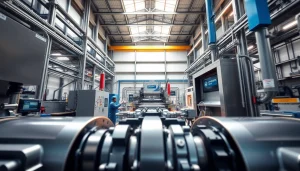Mastering HM88: The Essential Guide to Precision Engineering in 2025

Understanding the HM88 Series in Precision Engineering
The HM88 Series plays a pivotal role in precision engineering, particularly within the domain of industrial applications and valve technologies. As industries continue to evolve, the demand for reliable and efficient components such as the HM88 Series becomes crucial. These products not only enhance operational efficiency but also ensure safety and precision in various applications. When exploring options, hm88 provides comprehensive insights into these advanced valve systems, which are designed to meet the rigorous demands of modern engineering.
What is HM88? Overview and Specifications
The HM88 series consists of high-performance valve systems engineered to deliver precision and reliability. Each valve is designed to facilitate the controlled flow of fluids, making them integral to numerous industrial processes. Key specifications of the HM88 Series include:
- Material Composition: Typically constructed from stainless steel or high-grade alloys to ensure durability and resistance to corrosion.
- Pressure Ratings: Capable of handling varying pressure levels depending on the model, often exceeding industry standards.
- Operating Temperature Range: Designed to operate efficiently under extreme temperature conditions, ensuring reliability in harsh environments.
Understanding these specifications is essential for engineers and procurement teams when selecting the appropriate valves for their applications. The HM88 series is particularly suited for environments requiring stringent performance metrics, such as oil and gas, chemical processing, and water treatment facilities.
Key Features of HM88 Series Valves
The HM88 Series boasts several features that set it apart from traditional valve systems:
- Direct Mount Design: The three-valve direct mount configuration allows for easy installation and minimal space requirements.
- Integrated Leak Detection: Many models offer built-in leak detection capabilities, promoting safety and operational integrity.
- Custom Configuration Options: The valves can be tailored to meet the specific requirements of a project, enhancing versatility.
These features not only promote ease of use but also contribute to the long-term efficiency of industrial operations, aligning with the industry’s need for innovation and reliability.
Applications of HM88 in Industrial Settings
The versatility of the HM88 Series makes it suitable for a variety of applications across different sectors:
- Oil and Gas Production: Used in managing flow and pressure in pipelines and refineries.
- Chemical Processing: Ideal for controlling hazardous materials safely within processing plants.
- Water Treatment: Essential in the management of potable and wastewater systems.
By understanding these applications, stakeholders can better appreciate the impact of HM88 valves on operational efficiency and safety standards within their respective industries.
Installation Best Practices for HM88 Series Products
Proper installation of the HM88 Series is critical to ensuring optimal performance and longevity. Adhering to best practices can significantly reduce the risk of malfunctions and enhance overall efficiency.
Preparing Your Workspace for HM88 Installation
Before commencing installation, ensure that your workspace is equipped with the necessary tools and resources:
- Tools Required: Wrenches, screwdrivers, and alignment tools are essential for proper installation.
- Safety Gear: Wear appropriate PPE, such as gloves and goggles, to ensure personal safety during installation.
- Clean Environment: Maintain a clean workspace to prevent contamination and ensure component integrity.
Step-by-Step Guide to Installing HM88 Valves
- Initial Inspection: Inspect the valves for any shipping damage or defects.
- Align Connections: Ensure that the valve’s connections align perfectly with the piping system.
- Secure Fixings: Use appropriate tools to securely fasten the valves into place, following torque specifications.
- Testing: Conduct pressure tests post-installation to verify that there are no leaks and that the system operates smoothly.
Common Installation Missteps to Avoid
Avoiding common pitfalls during installation can save time and resources:
- Neglecting Alignment: Improper alignment can lead to premature wear or failure.
- Insufficient Torque: Failing to adhere to specified torque settings can result in leaks or system failure.
- Ignoring Manufacturer Guidelines: Always refer to the manufacturer’s installation instructions for the best results.
Maintenance Strategies for Optimal HM88 Performance
Ensuring the longevity of HM88 valves involves implementing a robust maintenance strategy. Regular maintenance not only prevents unexpected failures but also maximizes operational efficiency.
Routine Maintenance Tasks for HM88 Series
Routine maintenance tasks should include:
- Regular Inspections: Routinely check for signs of wear, corrosion, or leaks.
- Lubrication: Ensure that moving parts are adequately lubricated to minimize friction and wear.
- Functionality Testing: Regularly test the valve’s functionality to ensure optimal performance.
Troubleshooting Common Issues with HM88
Despite best efforts, issues may arise. Common problems include:
- Leakage: Often caused by improper installation or worn seals. Inspect and replace as necessary.
- Valve Sticking: Clean and lubricate the valve to ensure smooth operation.
- Pressure Loss: Check for blockages or damage in the system that may affect functionality.
When to Seek Professional Assistance
Some situations may require professional intervention:
- Complex Repairs: If a valve is beyond basic troubleshooting, consult a professional technician.
- Major System Failures: Seek assistance immediately if a system failure poses a risk to safety or operations.
Future Trends Impacting the HM88 Series and Precision Engineering
The landscape of precision engineering and valve technology is continually evolving. Emerging trends indicate that the HM88 Series will adapt and innovate to meet future challenges.
Emerging Technologies in Valve Engineering
New technologies are enhancing the capabilities of valve systems:
- Smart Valves: Integration of IoT technology enables real-time monitoring of valve performance.
- Advanced Materials: Development of new alloys and composite materials increases strength and resistance to corrosion.
- Automation: Automated systems are becoming an industry standard, facilitating easier management of valve operations.
Predictions for HM88 Evolution by 2025
Industry experts predict that by 2025, the HM88 Series will evolve to incorporate more advanced features:
- Enhanced Connectivity: Increased integration with digital systems for better data analytics.
- Improved Efficiency: Continued focus on energy-efficient designs to reduce operational costs.
- Customization: Greater emphasis on customized solutions to cater to specific industrial needs.
How Automation is Shaping the Future of Precision Engineering
Automation is not merely a trend but a revolution in precision engineering:
- Increased Precision: Automated systems deliver higher accuracy and repeatability in valve operations.
- Reduced Labor Costs: Automation minimizes the need for manual oversight, reducing operational costs.
- Real-time Data Collection: Enhanced data collection methods are leading to better decision-making and predictive maintenance strategies.
Case Studies: Successful Implementations of HM88 in Industry
Real-world applications of the HM88 Series illustrate the efficacy of these valves in various sectors. Several case studies showcase their impact on operational efficiency and safety.
Real-World Example: HM88 in Oil and Gas Applications
In the oil and gas sector, a leading firm implemented the HM88 Series to manage flow control in their pipeline systems. By adopting these valves, they reported:
- 30% Reduction in Downtime: Improved reliability led to a significant reduction in maintenance needs.
- Enhanced Safety: Integrated leak detection features minimized the risk of spills and accidents.
How HM88 Enhanced Efficiency in Manufacturing
A manufacturer specializing in chemical products integrated HM88 valves in their production line:
- Increased Throughput: The valves allowed for quicker transitions between production stages, resulting in a 25% boost in overall output.
- Better Process Control: Enhanced precision in flow rates improved product consistency and quality.
Client Testimonials Regarding HM88 Series Products
Feedback from clients has been overwhelmingly positive:
“The HM88 valves transformed our operations. Their reliability and efficiency have exceeded our expectations!” – Operations Manager, Chemical Processing Facility
Such testimonials underline the importance of the HM88 Series in enhancing operational performance across diverse industries.




